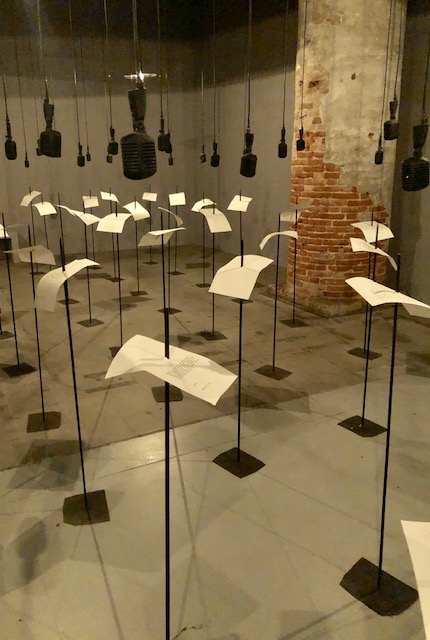Venice Biennial 2019... (Part II)
7:33 p.m.
18/07/19 - The other exhibition venue at the Venice Biennial is Arsenale. Located approximately 500 mts from Giardini, its spaciousness allows the presence of large-scale installations. Yin Xiuzhen’s Trojan, for example, is 5 mts tall and it represents a woman in bracing position. The image, so tragic, dressed in used clothes, illustrates one of China’s contradictions: the tensions between Tradition and Modernity.
Trojan, by Yin Xiuzhen (2016-17)
Materiales: steel panels, used clothes
In this Biennial, the curator decided to distribute pieces by one same artist in both exhibition spaces (Giardini y Arsenale). For instance, artist Gabriel Rico (Mexico 1980), who we saw at Giardini, can be found here once again closely linked to Nature and geometry, but with an installation that seems more poetic. Still working with Mathematics (the title of the piece refers to Renaissance’s quest for perfect proportions), he presents a bird watching a circle.
Sección áurea, de Gabriel Rico (2017)
Material: branch, gold, stuffed bird
The same happens with Shilpa Gupta who, with very different pieces, shows his potential by presenting a sound installation made with music score sheets stabbed with harpoons. Above each of them there’s a suspended mic and through it we listen to songs or voices in different languages, according to what’s written in the papers. The texts belong to a hundred poets, from the 7th century to our days, incarcerated because of their political views. The sounds of the installation include or exclude us depending on the language we can understand.
For, in your tongue, I Cannot fit, by Shilpa Gupta, 2017-18
Sound installation, mics, written words and metal.
Another example is that of Sun Yuan and Peng Yu, who here present a white silicone chair, reassembling those of the Roman Empire, behind a Plexiglas window. From the chair comes a rubber hose that, from time to time, moves violently. In between those movements, the quietness in the room gives no hint on what’s about to happen. Dear belongs to that type of works that makes it interesting to watch how people react to an unexpected event.
Dear, by Sun Yaun and Peng Yu
Materials: air plumb, air tank, hose and chair.
Andra Ursuta, who did the inverted trash spines at Arsenale, presents here a series of glass sculptures. They look like pieces of human bodies, but watching them can be a bit tragic-comic: dismembered bodies that have bottle caps instead of arms. After a more dedicated observation, we wonder if these are recreations of classic statues, or if they represent aliens or human beings that suffered amputations.
Succubustin’ Loose, ImpersonalGrowth/I Don’t Feel at Home in the World Anymore, Yoga Don’t Help, Predators y otros, by Andra Ursuta (2019)
Materials: glass, plastic
Haris Epaminonda (Chipre, 1980) obtained the Grand Prize with VOL. XXVII., a mysterious combination of objects in an imaginary location and in an undefined time. In this setting, the objects make us think about time, the persistence of memory or maybe the harmony or discordance of existence.
Vol. XXVII, by Haris Epaminonda (2019)
Installation / Mixed technique
Which is then our conclusion of this Biennial? That we must learn new concepts and that the artists can help us in that process. That we must sharpen our capacity to accept ambiguity: something is beautiful and ugly at the same time, attracts us or repel us, just as human nature does (in a world where there’s little room for ambiguity, art is the perfect platform in which we can see ourselves). And that we must remain active in front of the artworks: be players rather than just observers...




















0 comentarios